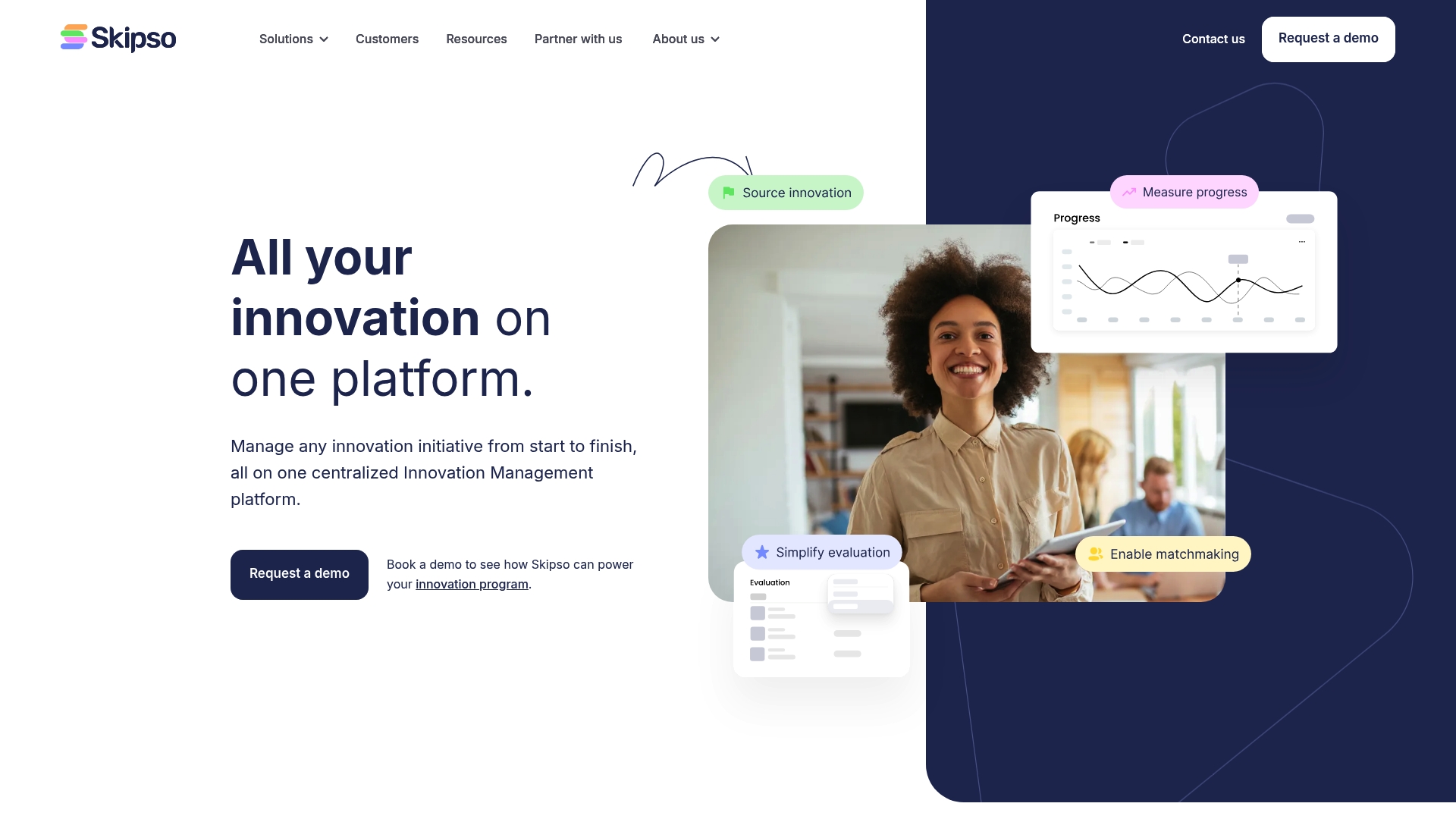


Corporate Innovation Strategies: Complete Guide
Did you know that businesses investing in innovation are over 50 percent more likely to outperform their competitors in revenue growth? Staying ahead in today’s market means adopting approaches that spark new ideas and transform the way companies operate. True innovation relies on deliberate strategies that foster creativity, encourage collaboration, and turn promising concepts into real-world success.
Table of Contents
- Defining Corporate Innovation Strategies Today
- Major Types Of Innovation Models In Corporations
- Implementing Effective Innovation Processes
- Roles And Responsibilities For Innovation Management
- Common Challenges And How To Overcome Them
- Case Studies Of Successful Innovation Initiatives
Key Takeaways
| Point | Details |
|---|---|
| Holistic Approach | Successful corporate innovation requires a comprehensive strategy that fosters creativity and cross-departmental collaboration. |
| Diverse Innovation Models | Companies should leverage various innovation models to align efforts with strategic objectives and market needs. |
| Emphasis on Culture | Building a culture that embraces experimentation and learning helps overcome common innovation challenges. |
| Continuous Engagement | Regular collaboration with stakeholders and customers is essential to drive sustainable innovation processes. |
Defining Corporate Innovation Strategies Today
Corporate innovation strategies represent systematic approaches organizations use to generate, develop, and implement transformative ideas that drive competitive advantage. According to Harvard Professional, these strategies encompass multiple dimensions including product innovation, process innovation, and business model innovation, each contributing uniquely to organizational growth and market responsiveness.
Corporate innovation is not a singular activity but a comprehensive organizational commitment. As Open University research indicates, modern innovation strategies systematically pursue significant improvements across multiple domains:
- Product Development: Creating novel solutions addressing emerging market needs
- Process Enhancement: Streamlining internal workflows and operational methodologies
- Marketing Innovation: Developing cutting-edge approaches to customer engagement
- Organizational Practices: Restructuring systems to promote continuous learning
Successful corporate innovation strategies today demand a holistic approach that transcends traditional departmental boundaries. Organizations must cultivate environments where creativity flourishes, interdisciplinary collaboration is encouraged, and calculated risk-taking becomes a cultural norm. This requires deliberately designed ecosystems that support idea generation, rapid experimentation, and adaptive learning.
By integrating innovation management techniques, companies can transform innovation from an intermittent activity into a sustainable, strategic capability. The goal is not just generating ideas, but creating robust frameworks that consistently translate creative insights into tangible business value.
Major Types Of Innovation Models In Corporations
Corporate innovation is a multifaceted approach with diverse strategic models that organizations leverage to drive growth and competitive advantage. According to Pressbooks, corporations typically adopt four fundamental innovation models that address different organizational needs and market opportunities.
Innovation Models represent structured approaches to generating and implementing transformative ideas. These models can be categorized into distinct types:
Here’s a comparison of the major corporate innovation models and their characteristics:
| Innovation Model | Key Focus | Typical Outcomes |
|---|---|---|
| Incremental Innovation | Small, ongoing improvements | Enhanced reliability Improved efficiency |
| Disruptive Innovation | Breakthrough technologies | New markets Displaced competitors |
| Architectural Innovation | Reconfiguring tech/components | New customer segments Expanded product lines |
| Radical Innovation | Entirely new technologies | Market transformation Unique value propositions |
- Incremental Innovation: Small, continuous improvements to existing products or services
- Disruptive Innovation: Introducing breakthrough technologies that fundamentally reshape market dynamics
- Architectural Innovation: Reconfiguring existing technologies to create new market opportunities
- Radical Innovation: Developing entirely novel technologies and market solutions
Additionally, IMD research highlights complementary innovation dimensions that organizations must consider:
- Process Innovation: Enhancing internal operational efficiency and workflow optimization
- Product Innovation: Developing new or significantly enhanced product offerings
- Business Model Innovation: Reimagining how value is created and delivered to customers
- Strategic Innovation: Redefining market positioning and competitive strategies
Successful corporations recognize that innovation is not a one-size-fits-all approach. By understanding diverse innovation models, organizations can strategically select and implement frameworks that align with their unique strategic objectives, technological capabilities, and market positioning.
Implementing Effective Innovation Processes
Implementing successful innovation processes requires a strategic and holistic approach that transforms organizational culture and operational frameworks. According to IMD, effective innovation implementation hinges on creating an environment that systematically encourages experimentation, allocates critical resources, and promotes cross-functional collaboration.
Key Innovation Process Components organizations must develop include:
- Dedicated Research and Development Infrastructure
- Structured Experimentation Frameworks
- Cross-Departmental Communication Channels
- Flexible Resource Allocation Mechanisms
- Continuous Learning and Adaptation Systems
Emeritus research highlights additional critical strategies for building robust innovation processes. These strategies emphasize the importance of:
- Embracing failure as a constructive learning opportunity
- Implementing data-driven decision-making protocols
- Leveraging comprehensive customer feedback mechanisms
- Adopting agile and responsive methodological approaches
To build a sustainable innovation process, organizations must move beyond traditional linear thinking.
 Success demands creating dynamic ecosystems that support continuous experimentation, rapid prototyping, and iterative development while maintaining alignment with overarching strategic objectives.
Success demands creating dynamic ecosystems that support continuous experimentation, rapid prototyping, and iterative development while maintaining alignment with overarching strategic objectives.
Roles And Responsibilities For Innovation Management
Innovation management requires a sophisticated approach to organizing, directing, and supporting creative initiatives within organizations. According to CMR-MIG, the roles and responsibilities differ significantly between startups and mature corporations, with established companies typically maintaining more structured processes and dedicated innovation teams.
Key Innovation Management Roles include:
- Chief Innovation Officer: Strategic oversight and alignment of innovation initiatives
- Innovation Managers: Day-to-day coordination of innovation projects
- Cross-Functional Team Leaders: Facilitating collaboration across departments
- Research and Development Specialists: Technical implementation of innovative concepts
- Innovation Culture Architects: Designing organizational environments that support creativity
Brookings research emphasizes the critical responsibilities of innovation management professionals:
- Coordinating with external stakeholders (universities, inventors, customers)
- Managing complex knowledge transfer processes
- Ensuring innovation strategies align with organizational objectives
- Developing collaborative networks both internally and externally
To build a successful innovation leadership approach, organizations must recognize that innovation management is not a single role but a comprehensive ecosystem of interconnected responsibilities that require strategic thinking, adaptability, and continuous learning.
Common Challenges And How To Overcome Them
Corporate innovation journeys are rarely smooth, with organizations consistently encountering complex obstacles that can derail creative initiatives. According to IMD, common challenges include deep-seated resistance to change, critical resource constraints, and fundamental misalignments between innovation efforts and core business objectives.
Primary Innovation Challenges organizations frequently encounter include:
- Cultural inertia and change resistance
- Limited financial and human resources
- Disconnected departmental strategies
- Fear of failure and risk-averse mindsets
- Inadequate innovation infrastructure
IMD research provides strategic insights into overcoming these challenges by:
- Encouraging interdisciplinary collaboration
- Breaking down organizational silos
- Investing consistently in continuous learning
- Creating psychological safety for experimentation
- Developing transparent communication channels
Understanding corporate innovation challenges requires recognizing that successful transformation is less about implementing perfect systems and more about cultivating an adaptable, learning-oriented organizational culture that views innovation as a continuous journey of strategic exploration and intelligent risk-taking.
Case Studies Of Successful Innovation Initiatives
Successful innovation initiatives demonstrate how strategic thinking and bold implementation can transform entire industries and organizational capabilities. According to IMD, companies like Tesla have revolutionized their sectors by developing comprehensive innovation strategies that extend beyond traditional product development.
Innovation Case Study Highlights reveal transformative approaches:
- Tesla: Vertically integrated battery and charging infrastructure
- Customized Direct-to-Consumer Sales Model: Reimagining automotive purchasing experiences
- Technological Ecosystem Development: Creating interconnected product and service platforms
- Strategic Risk-Taking: Challenging established industry paradigms
IMD research also showcases Amazon’s groundbreaking process innovation, illustrating how technological integration can fundamentally reshape operational efficiency:
- Robotics implementation in fulfillment centers
- Significant cost reduction strategies
- Enhanced delivery speed and customer satisfaction
- Data-driven operational optimization
Sharing success stories effectively becomes crucial in understanding how organizations can translate innovative approaches into tangible competitive advantages, demonstrating that true innovation transcends individual technologies and encompasses holistic strategic transformation.
Drive Your Corporate Innovation Strategy Forward with Skipso
Navigating the complexities of corporate innovation means overcoming challenges like cultural resistance, fragmented resources, and the need for agile experimentation. This article highlights the importance of structured innovation processes and dedicated leadership to transform ideas into impactful business value. If you’re committed to building a sustainable innovation pipeline that bridges strategic objectives with actionable outcomes, the journey starts with the right tools and ecosystem.

Empower your organization with Skipso — the leading innovation management platform designed to support every step of your innovation lifecycle. Whether you are launching corporate innovation challenges, managing startup accelerators, or driving ecosystem collaboration, Skipso offers the infrastructure to turn your innovation strategy into measurable success. Do not wait to create an adaptable, learning-oriented culture. Visit Skipso’s platform now to discover how you can overcome common innovation obstacles and transform your business. Start shaping the future today.
Frequently Asked Questions
What are corporate innovation strategies?
Corporate innovation strategies are systematic approaches that organizations use to generate, develop, and implement transformative ideas for gaining a competitive advantage. They encompass product, process, marketing, and organizational innovation.
What are the major types of innovation models in corporations?
The major types of innovation models include Incremental Innovation, Disruptive Innovation, Architectural Innovation, and Radical Innovation, each focusing on different aspects of growth and market opportunities.
![]()
How can organizations effectively implement innovation processes?
Organizations can implement effective innovation processes by creating environments that encourage experimentation, allocating critical resources, promoting cross-functional collaboration, and establishing dedicated research and development capabilities.
What common challenges do organizations face in corporate innovation?
Organizations frequently encounter challenges such as cultural resistance to change, limited resources, disconnected departmental strategies, and fear of failure. Overcoming these challenges requires fostering collaboration and creating a supportive innovation culture.
Recommended













